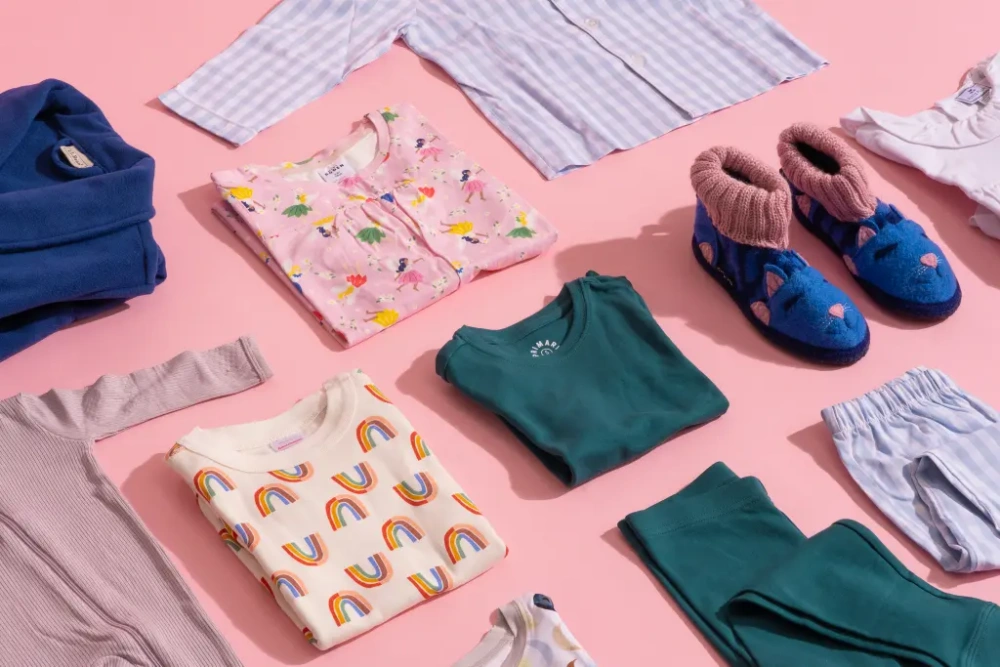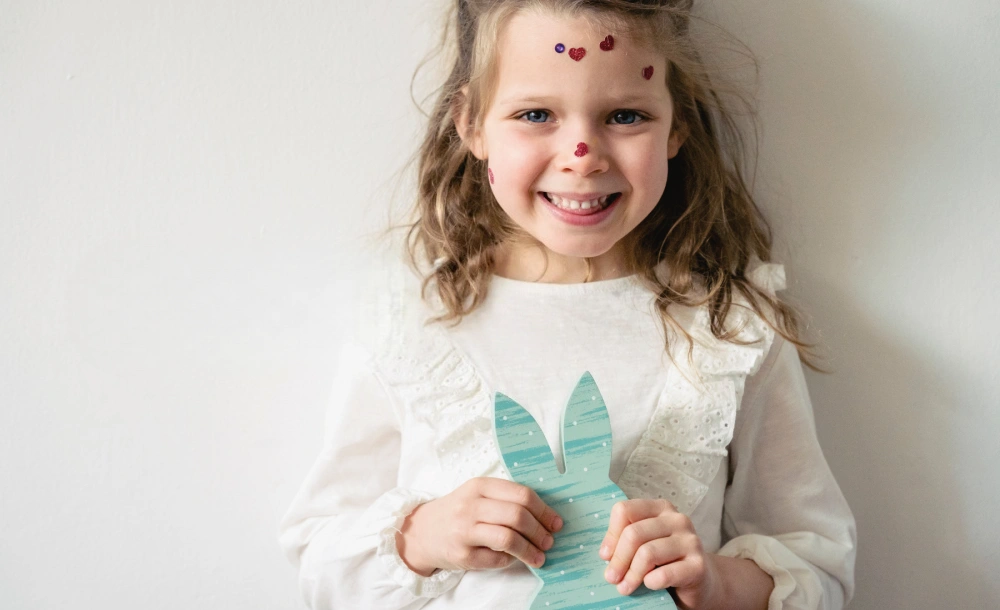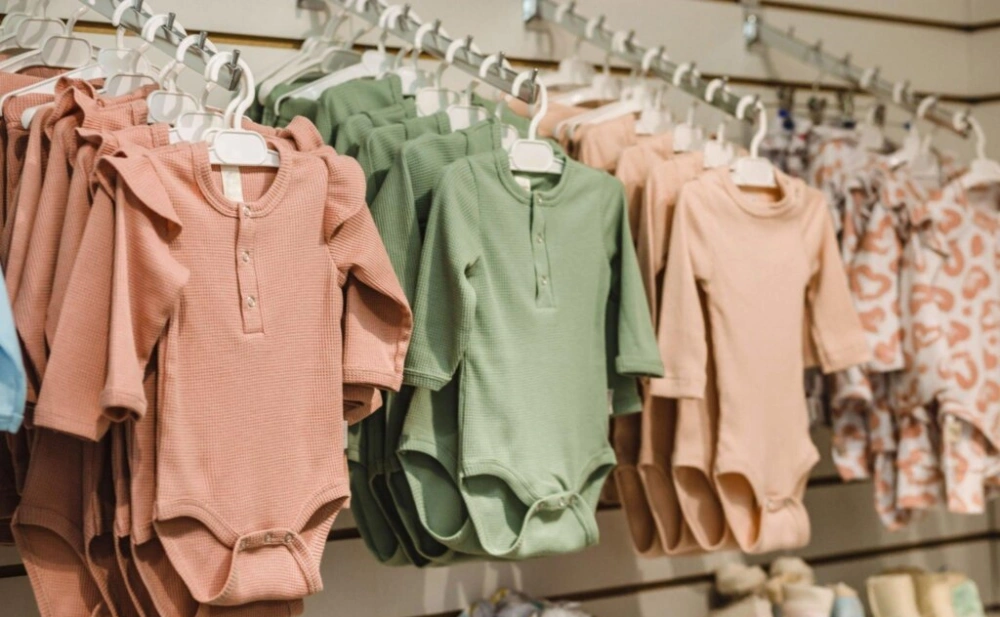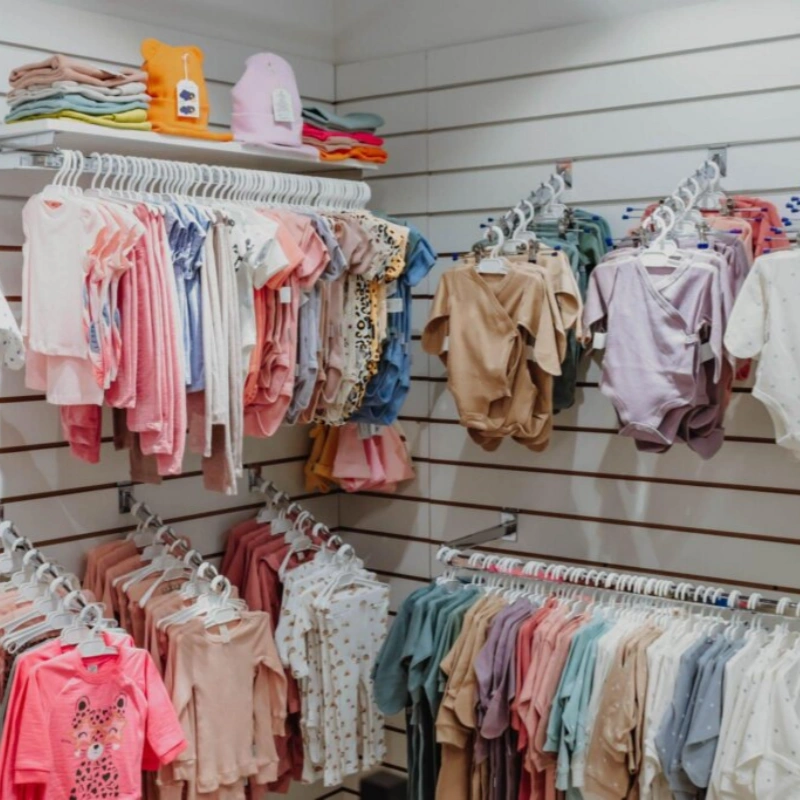You can learn how to start a kids’ clothing line with a smart plan and a tight budget. The global kids’ clothing market keeps growing, making this a great time to jump in.
Year | Market Size (USD Billion) | CAGR (%) |
|---|---|---|
2024 | 211.57 | 7.17 |
2032 | 366.72 | — |
Many new brands use creative ways to save money when they start a clothing line:
Source gently used fixtures
Build a strong digital marketing presence
Choose flexible inventory and budget options
Trusted manufacturers like Friendtex help you keep costs low while delivering top quality. Even if you’re new, you can succeed if you plan your baby clothing line carefully, focus on your brand, and manage your baby clothing budget wisely. Your baby clothing dream is within reach!
Key Takeaways
Research kids’ fashion trends and competitors to find what parents want and spot market gaps.
Define a clear target audience and create a unique selling point that makes your brand special.
Build a strong brand identity with a memorable name, logo, and story that connects with parents.
Partner with trusted manufacturers like Friendtex to produce quality clothes with low minimum orders.
Use online stores and social media marketing to launch your brand affordably and grow with customer feedback.
Market Research
Kids Fashion Trends

If you want your baby clothing store to stand out, you need to know what’s hot in the kids’ market right now. Trends change fast, but you can spot them without spending a lot.
Start by checking out social media, fashion blogs, and free industry reports. You’ll see that kids’ clothing is all about comfort and personality these days. Here are some of the top trends you’ll notice:
Gender-neutral clothing is everywhere. Parents love options that work for any child.
Urban-inspired looks are making their way into baby and kids’ clothing, with city styles showing up in prints and cuts.
High-fashion comfort is a big deal, especially for infants. Think soft fabrics with a touch of luxury.
Animal motifs are super popular in baby clothing. You’ll see everything from cute bears to playful dinosaurs.
Personalized and custom labels are trending. Parents want unique pieces for their kids.
If you plan your collection around these trends, your baby clothing store will attract more attention and feel fresh.
Competitor Analysis
You can’t build a successful children’s clothing line without knowing what other brands are doing. Start by searching for other baby clothing stores and children’s clothing stores online. Look at their collections, prices, and what makes them special.
Automated tools and AI-powered platforms like Retviews help you track competitor strategies in real time. These tools show you what’s selling, what’s missing, and where you can fill a gap.
When you analyze competitors, you might spot that many brands focus on sustainability or e-commerce, but some miss out on personalization or certain age groups.
By watching these patterns, you can plan your clothing line to meet needs that others ignore. This approach helps you find your place in the market and build a baby clothing brand that stands out.
Tip: Use free tools like Google Trends, Instagram hashtags, and competitor websites to gather ideas for your plan. You don’t need a big budget to get valuable insights!
Define Your Niche
Target Audience
When you start a clothing line for kids, you want to avoid wasting time and money by trying to please everyone. Instead, focus your plan on a specific group.
Most successful children’s clothing lines target parents of babies and toddlers, but don’t forget about other buyers. Professional aunts with no kids (PANKs) often buy gifts for their nieces and nephews. They care about quality, style, and fun designs.
Here’s a quick look at who buys the most baby and kids’ clothing:
Buyer Type | Age Range | What They Value |
|---|---|---|
Parents | 25-40 | Comfort, safety, price |
PANKs | 33-52 | Unique gifts, style, quality |
Grandparents | 50+ | Durability, tradition |
You should also think about lifestyle and values. Some families want eco-friendly baby clothing. Others look for trendy, Instagram-worthy outfits. Many want soft, easy-to-wash clothes for busy mornings. If you know your audience, you can design some styles that connect.
Tip: Use surveys or social media polls to ask parents and caregivers what they want most in baby and children’s clothing. Their answers can shape your plan.
Unique Selling Point
Your unique selling point (USP) is what makes your children’s clothing line stand out. Maybe you offer organic baby pajamas, themed collections, or custom name embroidery. To find your USP, follow these steps:
Pick your niche—like luxury baby sleepwear or playful, affordable basics.
Check what other brands do. Look for gaps in the market.
Test your ideas with real parents and kids. Ask for honest feedback.
Use what you learn to improve your designs and your plan.
Keep your USP simple and clear. Make it the heart of your brand.
The most profitable niches in the market right now include customizable basics, dress-up outfits for holidays, and soft athleisure for active kids. Parents and gift-givers love clothing that feels special but is easy to care for. If you focus on comfort, style, and a little bit of fun, your baby clothing line will have a strong chance to grow.
Brand Identity

Building a strong brand identity is your secret weapon in the kids’ clothing world. When you create a brand that feels memorable and trustworthy, parents will keep coming back for more. Let’s break down how you can do this without spending a fortune.
Name and Logo
Your brand name and logo are the first things people notice. You want something catchy, easy to remember, and simple to spell. Use free tools like Namechk to check if your brand name is available on social media and as a website. Pick a name that matches your brand’s vibe—fun, modern, or classic.
For your logo, you don’t need to hire an expensive designer. Try free or low-cost design tools like Canva or Looka. If you want to add your logo to clothing tags, DTF (Direct-to-Film) transfers are a smart choice.
They’re affordable, work on any fabric, and last through many washes. You can order small batches, so you don’t have to spend a lot upfront.
Tip: Keep your brand colors and logo style consistent everywhere—on your website, tags, and packaging. This helps people remember your brand.
Story and Values
Your brand story is what makes you stand out. Parents want to buy from brands that share their values. If your brand cares about sustainability, comfort, and style, say it loud and clear.
Share why you started your brand and what makes your products special. Maybe you use eco-friendly fabrics or support fair working conditions. These details matter.
Check out this table to see how different parts of your brand identity help build loyalty:
Brand Identity Element | Focus Area | Impact on Customer Loyalty and Business |
|---|---|---|
Unique Mission Statement and Value Proposition | Sustainability, style | Builds trust and aligns with customer values |
Logo and Brand Colors | Memorable design | Boosts recognition and consistency |
Brand Story | Emotional connection | Strengthens loyalty and sets you apart |
Consistency Across Touchpoints | Uniform messaging | Reinforces trust and retention |
When you show your commitment to quality and share your brand’s journey, you connect with parents on a deeper level. That’s how you turn first-time buyers into loyal fans.
How to Start a Kids’ Clothing Line with Friendtex?

Starting your own kids clothing line can feel overwhelming, but with Friendtex, you can make it simple and affordable. If you want to know how to start a kids’ clothing line without a huge investment, you’ll love how Friendtex supports new brands and small businesses.
Let’s break down how you can use Friendtex to launch your baby clothing store, stand out in the market, and keep your costs low.
Low-Investment Production
You don’t need a massive budget to get started. Friendtex specializes in helping you launch your baby clothing store with small-batch production and private label options. Here’s why so many new brands choose Friendtex:
You get full support, from design help to fabric sourcing and size grading. This means you can focus on your vision while Friendtex handles the technical details.
Friendtex offers low minimum order quantities. You can test new styles or trends without buying too much inventory. This keeps your risk low and lets you react quickly to what your customers want.
The materials are always high-quality, safe, and hypoallergenic. Parents trust your baby clothing store when they know you care about their children’s comfort and safety.
Friendtex manages packaging and logistics, so you don’t have to worry about shipping or storage headaches.
Fast and reliable delivery helps you meet deadlines, especially during busy seasons like holidays.
You can choose from trendy, customizable styles that help your brand stand out in a crowded market.
Tip: If you’re wondering how to start a baby clothing line with minimal risk, start with a small batch. You can always scale up as your baby clothing store grows.
Friendtex Kids Pajamas
When you think about launching a kids’ clothing line, pajamas are a great place to start. Friendtex offers a wide range of kids’ pajamas that combine comfort, safety, and playful designs. Here are some of the most popular options you can add to your children’s clothing store:
Kids’ Christmas Pajamas: These bring holiday cheer with soft, skin-friendly fabrics and fun prints. You can order sets, nightgowns, or robes in materials like organic cotton, bamboo, fleece, flannel, satin, or silk.
Kids’ Silk Pajamas: Give your baby clothing store a touch of luxury. These pajamas are gentle on sensitive skin and perfect for all seasons.
Kid Onesie Pajamas: These are always a hit with kids. Choose from character onesies, animal themes, or seasonal designs. They come with easy-zip closures, elastic cuffs, and hypoallergenic fabrics.
Kids’ Cotton Pajamas: These are classic, breathable, and durable. Parents love them for everyday wear, and you can offer both lightweight and thicker options for different seasons.
Winter Pajamas for Kids: Keep kids warm and cozy with fleece or cotton options. These pajamas feature adjustable waistbands, reinforced knee patches, and ribbed cuffs for extra comfort.
Friendtex pajamas meet strict safety and quality standards. They hold certifications like OEKO-TEX®, GOTS, SEDEX, and more. All pajamas comply with U.S. flammability standards and use materials that are gentle and safe for babies.
Friendtex even tests for harmful chemicals and ensures every batch meets high durability and breathability standards. This level of care puts your brand above the competition and builds trust with parents.
Note: Friendtex’s commitment to sustainable manufacturing and eco-friendly fabrics means you can offer products that are good for both kids and the planet.
Customization Options
You want your baby clothing store to stand out, and Friendtex makes it easy to create unique products. Their customization options help you build a brand that parents remember. Check out what you can personalize:
Customization Option | Description |
|---|---|
Fabrics | Choose from cotton, bamboo, satin, linen, and more—perfect for kids’ sensitive skin. |
Colors | Pick from a wide range to match your brand’s style. |
Sizes | Offer newborn, baby, toddler, and kids’ sizes with professional size grading. |
Prints | Add custom prints and kid-friendly designs that last. |
Styles | Select from two-piece sets, footies, nightgowns, robes, and more. |
Packaging | Use eco-friendly packaging to support your sustainable brand image. |
Add woven tags, custom prints, or eco-labels for private label branding. | |
Design Features | Include button or zipper closures, adjustable cuffs, elastic waistbands, and reinforced knees. |
OEM/ODM Services | Get full-service support, from fabric recommendations to production and labeling. |
Minimum Order Quantity (MOQ) | Start with as few as 300 sets per style and color—great for new or small brands. |
You can request a quote for exact pricing, so you always know what to expect. Friendtex’s flexibility means you can try new ideas, launch themed collections, or respond to trends fast. This is a huge advantage when you’re learning how to start a kids’ clothing line and want to keep your baby clothing store fresh and exciting.
If you want to know how to start a kids’ clothing line that feels unique, focus on customization. Parents love buying clothing that feels special for their baby.
With Friendtex, you get a partner who cares about your success. You can launch your kids’ clothing line with confidence, knowing you have support at every step. Whether you want to start small or dream big, Friendtex helps you turn your baby clothing vision into reality.
Launch and Grow
Online Store Setup
Ready to launch your online baby clothing brand? You can set up an online store for baby clothes without breaking your budget. Start by getting the right permits and licenses.
These usually add just a small percentage to your total budget to launch. Next, find eco-friendly suppliers for your baby clothing. Negotiate for discounts on bulk orders to stretch your budget further.
Choose a platform that fits your budget and needs. Shopify is a favorite for new brands. You can start for as little as $5 a month. Shopify gives you drag-and-drop tools, so you don’t need to code. You can build a mobile-friendly online baby clothing store that looks professional and works well on any device.
Add secure payment options and keep your website simple. Use bright photos of happy kids and families. Limit your menu to a few categories, like baby pajamas, onesies, and accessories. This makes shopping easy for busy parents.
Tip: Fill your online store baby clothes site with clear product descriptions and real photos. Parents want to see what their baby will wear!
Digital Marketing for Kids’ Clothing Line
You need creative marketing to build an audience and drive sales for your online baby clothing brand. Social media is your best friend here. Post photos and videos of your baby clothes online on Instagram and TikTok.
Partner with parent influencers and mommy bloggers. Micro-influencers often have the most loyal followers and can help you sell children’s clothes online with real, relatable stories.
Encourage parents to share photos of their kids in your clothing. User-generated content builds trust and shows off your brand’s style. Run contests or use branded hashtags to get more people involved.
Invest a small part of your budget in social media ads. Target parents by age, interests, and location. Write blog posts about baby fashion and parenting tips to boost your e-commerce site’s search ranking.
Note: Influencer marketing and user-generated content can drive up to 10% of sales for new online baby clothing brands.
Gather Feedback and Scale
After you launch your online store baby clothes business, keep improving. Ask customers for feedback with short surveys or polls. Offer a discount or giveaway to encourage responses. Watch your sales trends and see which baby clothing styles sell best. Use this data to adjust your product mix and plan your next collection.
Track key metrics like gross profit margin, inventory turnover, and customer retention. These numbers show how well your online clothing store is doing. Stay open to change.
If parents ask for new colors or designs, try a small batch first. Keep your budget flexible so you can reinvest profits into marketing or new baby clothing products.
Stay curious and keep learning from your customers. That’s how you grow your brand and become a leader in selling children’s clothes.
Conclusion
You can launch a kids’ clothing line with low investment by following a few smart steps:
Research the market and spot trends parents love, like eco-friendly fabrics.
Build a strong brand with a clear story and memorable visuals.
Start small with online sales and creative marketing.
Partner with trusted manufacturers like Friendtex for quality and growth.
Start today—your unique brand could be the next big thing in kids’ fashion! 🚀
FAQ
How much money do I need to start a kids’ clothing line?
You can start with as little as $500–$2,000 if you use small-batch production and digital marketing. Focus on a few styles first. Grow as you make sales.
Can I launch my brand if I have no design experience?
Absolutely! You can use free design tools or work with manufacturers like Friendtex. They offer design support and help you turn your ideas into real products.
What’s the best way to market my kids’ clothing line on a budget?
Social media is your best friend.
Share photos, run giveaways, and connect with parent influencers. Encourage happy customers to post pictures of their kids wearing your clothes.
How do I make sure my kids’ clothing is safe and high quality?
Choose certified manufacturers like Friendtex. Look for safety labels such as OEKO-TEX® or GOTS. Always check fabric quality and request samples before placing a big order.


